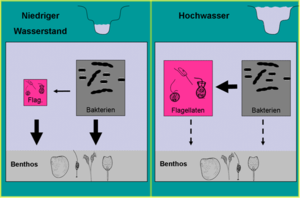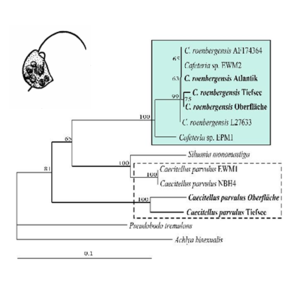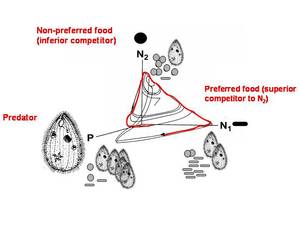Main Research Topics
River Ecology
We try to understand the functioning of large rivers. Our group is running a large research laboratory on the River Rhine which allows the study of the biology of running water animals in situ in flow channels and exposed substrates independent of the water level. A current topic is the analysis of the grazing of plankton by benthic organisms that can have a strong impact on the composition and functioning of the river system. Both the temperature and water level can strongly influence the intensity of the benthic control, giving rise to the hypothesis that the bentho-pelagic coupling in connection with small changes in the climate could generate large changes in the ecosystem composition and function. We aim to explain and predict the benthic impact on the development of different plankton groups in response to changing climate conditions in a large river ( Rhine ). By identifying temperature generated mismatches in the balance between the grazing rates of benthic consumers (mussels, insect larvae, sponges and biofilm communities) the numerical responses of selected grazers towards warming is investigated in experiments and field studies.
A very significant problem for the functioning of large rivers is the introduction of neozoans, novel communities are established which completely changed the matter flux in the River Rhine. The following important invasive species are currently investigated regarding their impact on the matter flux such as food selectivity, temperature response and effects of bioturbation: chinese midden crab (Eriocheir sinensis), asian clam (Corbicula spp.), polychaet worm Hypania invalida and freshwater sponges.
Of special interest are interactions between macrofauna organisms and plankton communities as well as biofilm communities.
These biofilms form another focus of our investigations in the River Rhine. Natural surface-attached communities are composed of bacteria, algae, fungi, and “animals” (protozoans and small metazoans). Consequently, we as ecologists consider biofilms as “complex communities of microbiota". We investigate unicellular grazers (protozoans) in controlling the structure of biofilm-dwelling bacteria communities under natural and semi-natural conditions. Biofilms can be analyzed "in situ" in micro-chambers (‘flow cells’) and inoculated by the discharge of either natural water from the River Rhine (the grazer composition can be manipulated by size fractionation) or by field isolates of complex bacterial communities in combination with the controlled addition of specific grazers. These different approaches allow to test the effects of natural grazer communities with different complexities. We could show that biofilms significantly influence the structure of the surrounding plankton community.
Marine Biology
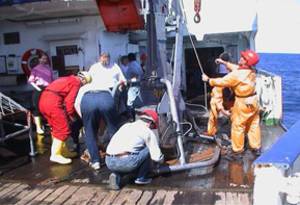
Marine systems form the largest part of the biosphere. Deep-sea bottom (depths larger than 1000m) covers more than the half of the earth surface. It is amazing how little we know about the biological processes and the biodiversity in this important ecosystem. We took part in several deep-sea expeditions to study the diversity of unicellular eukaryotes as the by far most productive component among marine eukaryotes. The research on unicellular eukaryotes is challenging since nearly nothing is known about their contribution to tha deep-sea marine life. Recent studies were aimed to recognize possible relationships between the primary production in the water column and the benthic biodiversity. Moreover, possible biogeographic barriers between the different deep-sea basins in the Atlantic and Mediterranean were analyzed. An additional goal is to prove whether there exists a latitudinal diversity gradient along transects within deep-sea basins. In approximately 5,000m depth, the organismic biodiversity of all size classes (from nano- up to megafauna) is surprisingly high. Each single sample contains a lot of new species and even new families. We co-operate especially with the Senckenberg Museum in Frankfurt/M. and Wilhelmshaven (Prof. Martinez, Prof. Türkay) and the Free University of Berlin (Prof. Hausmann). The methods we apply are isolation and cultivation of deep-sea protists, the morphological analysis and molecular identification of species, the establishment of clone libraries of uncultivated samples and the study of the specific ecology of deep-sea protists using laboratory experiments. In addition, we are interested in the global distribution of marine protists in surface waters from the Arctic to the Tropics.
MGF Ostsee
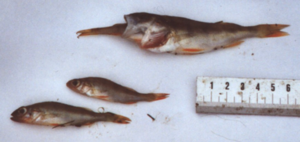
The MGF Baltic Sea research project offer the unique opportunity to investigate how benthic habitats and organisms develop after the exclusion of MGF in the future. For this purpose, the current state of the areas has to be examined and documented first as a reference, in order to investigate how communities, seabed morphology, biogeochemistry of the marine sediments and exchange processes between sediment and water column develop without further human disturbances. Such influences on MPAs and marine ecosystems have so far been understudied and the results provide an important basis for future management of the protected areas in the North and Baltic Sea. The scientific work planned in the projects follows a modern, interdisciplinary approach that includes all components of the ecosystem in order to assess the consequences of an MGF exclusion. The major task of the Cologne group is to investigate the impact on benthic heterotrophic protists.
Molecular Ecology
Molecular methods are used in our group at the moment to study the phylogeny of protists and metazoans, the diversity of phylotypes, populations genetics, microevolutionary processes and gene expression patterns. Actually, protists are in the major focus of our studies. Despite many decades of study, their diversity in natural ecosystems is still rather poorly known, as is the extent to which many of these species are distributed on our planet. Protists are still a white area for research, many new interesting species can be detected and even important new genera and families are still undiscovered. These ‘unknown, uncultured phylotypes’ represent species, genera and higher-level taxa of protists that have not yet been described based on morphological criteria, and which have not yet been studied regarding their ecology. Some of these taxa are very important regarding the matter flux in their habitats. In the deep sea, groundwater and polar regions, the largest habitats of the biosphere, nanoprotists show an enormous up to now undiscoverd diversity with important functions for the stabilty of the ecosystems. Methods applied in our group at the moment are single cell PCR, establishment of clone libraries, 454 sequencing of protist communities, microsatellite analyses, etc.
Theoretical ecology and chaos research
Finding out why natural population densities change over time and vary depending on location is one of the central goals of ecology. The recognition that even simple ecological systems have the potential for chaotic behaviour has made chaos a topic of considerable interest among theoretical ecologists. However, there is still a lack of experimental evidence to demonstrate that chaotic behaviour occurs in the real world of coexisting populations in multi-species systems.
We study the dynamics of defined predator-prey systems in controlled systems (e.g. chemostats) as model systems to understand the role of chaotic and other intrinsic dynamics in the "real world". In the course of a long series of autecological studies of protists in chemostats and batch systems we arrived at a defined chemostat system consisting of multi-species–systems which can be studied regarding the different types of dynamic behaviour, stable coexistence, limit cycles and even chaos.
Apart from the intuitive understanding that external (extrinsic) stimuli (such as temperatures) influence the variability of abundances, we hope to understand the internal (intrinsic) characteristics of a population which give rise to population dynamics with large and (at certain parameter ranges) even chaotic fluctuations of abundances even under constant and predictable conditions. We are just at the beginning to understand the role of intrinsic fluctuations in nature and are on the way to study the type and properties of chaotic attractors in experimental systems.
Polar Research

As polar regions are severely affected by global warming, the effects of rising temperatures in aquatic systems can be studied. The defined spatial and temporal separation of the polar regions offers the opportunity to study potential speciation and population genetics of protists. In polar regions, heterotrophic nanoflagellates are major consumers of bacteria and contribute significantly to the carbon flux from DOC via bacteria to larger organisms such as ciliates and metazoans. Heterotrophic flagellate biomass may greatly exceed bacterial biomass in the sea ice. According to our recent molecular biological and morphological studies of Antarctic and Arctic nanofauna, morphological investigations reveal only limited taxonomic resolution for these tiny organisms (mainly 2-8µm cell size). Many morphotypes contain several genotypes with sometimes high evolutionary distances (p-distances of SSU rDNA). We study the role of endemism in polar waters, the discrepancies and overlaps between morphotypes, genotypes and ecotypes of selected taxa to draw conclusions regarding the possible effects of small changes in temperature on the sensitive Antarctic and Arctic ice biota. We take samples from Antarctic and Arctic sites, establish cultures of unicelluar organisms and analyse them combining morphological, molecular biological and ecological methods. Knowing more about the role of biodiversity of the most important bacterivorous components of Antarctic and Arctic ecosystems will support our understanding of ecological processes in polar regions. In addition, we investigate the global distribution of nanoprotists and analyze their potential global distribution. Bachelor, Master and Ph.D. students are incorporated in the project in laboratory and field work. The global distribution and the ways of distribution are studied using ice and snow as archives and air as transport media. Among our sampling sites are Svålbard (Spitsbergen), Greenland and Iceland in the North as well as the Antarctic Peninsula in the South. In the lab we use molecular (single cell PCR, 454 sequencing), morphological (high resolution video-enhanced microscopy, electron microscopy) and cultivation methods to analyse the samples.
